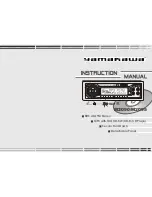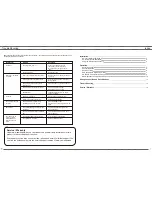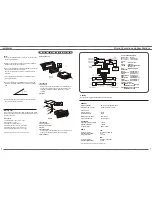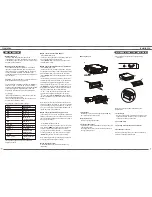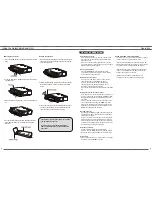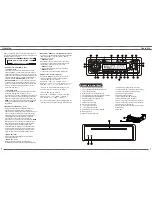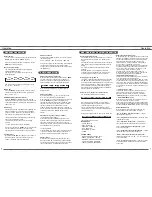
Operation
GENERAL OPERATION
•
•
•
•
•
• The MUTE Key
By pressing the “
MUTE
” key (#27) once, the volume is
reduced by 60 dB. If you press this key again, the
volume is increased to the old value again.
On/Off switch
You can switch on the unit with any key! (Except for the
“
OPEN
” Key (#7) and the “
EJECT
” key (#4).
When you want to switch the unit off again, press the
PWR
(power on/off) (#9) once.
Music playback settings
The music playback settings can be operated by
pressing the
SEL
key (#10).
The sequence of the settings can be seen in the
following diagram:
The volume can be adjusted by pressing the “
+
” key
(#11) or the “
–
“ key (#12).
MODE Key
Press the “
MODE
” key (#6) briefly in order to change
between the modes that can be set (e.g. radio to CD
(MP3) to CDC, etc.).
SUBWOOFER Key (Optional feature)
Keep the “
MODE
” key (#6) pressed down for a few
seconds to switch on the bass output. This function can
be switched off again by pressing and holding this key
down once more.
RESET Key
This key (#25) can be reached when the operating unit
has been folded down. This button can be activated
using a pen with a sharp nib or another metal object.
The reasons for activating this button include:
• setting all values back to standard when the unit has
been newly installed and cabled
• the remaining function keys are not functioning
properly
• an error symbol can be seen in the display.
NOTE: If you operate the “
RESET
” key and the unit does
not react, then clean the base on the back of the
operating unit with a cloth soaked in isopropyl alcohol.
•
•
•
•
Selecting the band wave/frequency
When the radio function has been selected, the “
BAND
”
key (#13) allows you to switch between frequency
bands. The sequence of the frequencies that can be
switched through is set out in the following diagram:
Note: Frequency display may vary and subject to
different country
Selecting the station
By briefly pressing the “ ” and “ ” keys (#16 and
#17), you can activate the automatic search.
When you keep one of the keys pressed down for a few
seconds, “
MANUAL
” appears in the display. This
signifies that manual search has been activated. Using
these keys you can now search by hand for a station
that has not been found by automatic search for
example. When neither of the two keys are pressed in
manual search for a few seconds, the unit switches back
to automatic mode again. “
AUTO
” appears in the
display.
Automatic storing and scanning of stations
•
Automatically storing stations
Press and hold down the “
APS
” key (#18) for a few
seconds. The unit now begins to search for stations on
the set band wave. After one pass, the 6 strongest
stations are recorded in the programme memory and are
now available on the 6 station keys.
• Scanning stations
Press the “
APS
” key (#18) briefly and the unit will begin
to search for stations. If the strength of the station is
sufficient, it will be reproduced for a few seconds.
Storing stations
Press one of the station memory keys M1-M6 (#14)
when you want to store a station. Press and hold down
one of the keys for a few seconds. Once a second beep
tone has been heard, the station has been stored.
Vol BAS T
RE BAL FAD
(Volume) (Bass) (Treble) (Balance) (Fader)
RADIO OPERATION
FM1 FM2 FM3 MW LW
• Activating the RDS function
Use the “
AF
” key (#3) to switch this function on and off.
When this function is activated, “AF” appears in the
display.
Provided that a station supports the function, the station
name and the song being played should appear in the
display.
“AF” begins to flash when the signal from a station
weakens.
“ALARM” appears in the display when important
messages are being broadcast. The volume is also
increased slightly if it has been set to a minimum.
• Setting regional programmes
This mode is activated and deactivated when you keep
the “
AF
” key (#3) pressed down for a little bit longer.
Some radio stations also broadcast over a regional area.
If this mode is switched on, then a regional transmitter
will be preferred on account of the better reception.
When this function is switched off, the unit switches to
and fro between the two signals.
• Using the “PTY” key (#1) to select the station
The sequence of this function is as follows:
When this function is activated, the unit searches
through all frequencies one after the other until the
corresponding value has been found.
If there is no result after several attempts to find a
suitable station, then the unit switches automatically to
normal search mode.
Notes: Various groups exist in “PTY” mode. These are:
These groups are divided into:
MUSIC GROUP
• POP M, ROCK M
• EASY M, LIGHT M
• CLASSICS, OTHER M
• JAZZ, COUNTRY
• NATIONAL M, OLDIES
• FOLK M
SPEECH GROUP
• NEWS, CURRENT AFFAIRS, INFO
• SPORT, EDUCATION, VARIED
• WEATHER, FINANCE, CHILDREN
• SOCIAL, RELIGION, PHONE-IN
• TRAVEL, LEISURE, DOCUMENT
• Traffic announcement mode (TA)
When the “
TA
” key (#2) (traffic announcement) has been
pressed, the CD (MP3) or CDC mode is active, then the
unit switches automatically over to a radio programme
when news and traffic announcements are being
transmitted. Here, a station with EON is searched for
and the volume is increased if it is too low.
As soon as the traffic announcements have finished, the
unit automatically switches back to the previous mode.
The current news or the traffic announcement can be
interrupted by pressing the “
TA
” key briefly.
The “
TA”
mode is not switched off here, however.
When the “
TA
” key is pressed down for a long time, the
unit automatically switches over to “
EON TA
LOCAL/EON TA DISTANCE
” mode.
This function has been implemented in order to prevent
an incorrect switch over to EON stations.
It can happen that the unit receives an “EON TA” signal
and switches to the corresponding station but this is too
far from the radio. Here, the unit switches automatically
to the original station. When this function is not activated
and a station is too far away, it may be that nothing can
be heard.
• “ EON TA LOCAL” mode
In this mode the unit switches to the other station if it
offers a better reception than the station that was
previously tuned to. When this function is activated,
“
EON TA LO
” appears for a few seconds in the display.
• “EON TA DISTANCE” mode
When this mode is activated, the unit tries to stay with
the current station during news or traffic
announcements. A search for local stations with possibly
better reception does not take place. When this function
has been activated, “
EON TA DX
” appears in the display.
• Transmitted RDS data
When the RDS function has been switched on, the
following data can be received from the station:
“PI”: “Programme Identification Code”
– code for
identifying the programme
“PS”: “Programme Service Name”
– the station name
is transmitted with this
“AF”: “Alternative Frequencies”
– transmission of
other frequencies that transmit the same programme
“TP”: “Traffic Programme Identification”
– traffic
announcement signal
“TA”: “Traffic Announcement Identification”
– signals
the transmission of a traffic announcement.
“EON”: “Enhanced Other Network Information”
–
transmitted data such as “PI”, “PS”, “AF”, etc., refer here
to the other station.
“PTY”: “Programme Type Code”
– shows the content
of the transmission, including the musical style of the
current item.
PTY Music group PTY SPEECH group PTY off
PTY Music group PTY SPEECH group PTY off
Operation
RDS (RADIO DATA SYSTEM) OPERATION
• Electronic equaliser
After pressing the “
EQ
” key (#28), you access control of
the following menu:
FLAT – CLASSIC – POP M – ROCK M – DSP OFF
Using these settings, the bass and treble of the playback
can be adjusted to the music style. Each of these
settings can be changed from the standard values using
the “
E.VOL
” key.
Summary of Contents for M2090 M2095
Page 2: ...Inside Covers Blank ...

